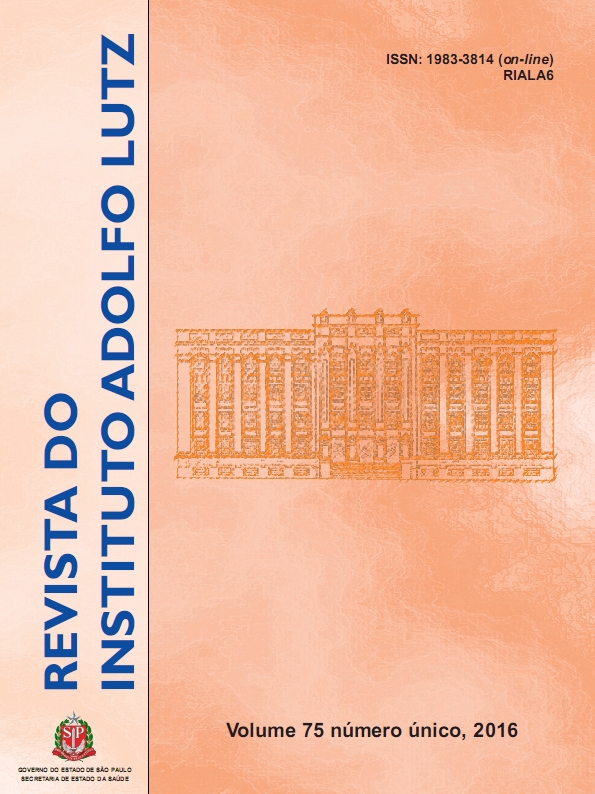Abstract
Aflatoxin contamination has been considered as a public health problem, especially in tropical countries, including Brazil. In order to investigate the presence of type B aflatoxins in products marketed in the city of Fortaleza, 23 samples were analyzed by thin layer chromatography. Visible fungal contamination in food was identified according to their macroscopic and microscopic features. The contamination by aflatoxins was detected in 8.7 % of 23 analyzed samples, and 12.5 % of Brazilian nuts samples were positive for AFB1 (<8 μg/kg) and for AFB2 in a contamination rate above the allowed value (16 μg/kg). Among the peanut samples, 33.3 % were positive to AFB1 and AFB2, also in a contamination rate (317.1 μg/kg) which was higher than that recommended by ANVISA. The isolation and morphological characteristics of fungi detected mainly in Brazilian nuts with peel showed the occurrence of the following species: Aspergillus flavus, Aspergillus niger, Mucor sp, Cladosporium sphaerospermum, Cladosporium cladosporoides, Fusarium sp, Aspergillus terreus and bacteria of Actinomycetes phylum. These findings indicate that it is needed to apply the mostly effective quality monitoring of food available to consumers.
References
1. Kwiatkowski A, De Faria Alves AP. Importância da detecção e do controle de aflatoxinas em alimentos. SaBios-Rev Saúde e Biol [Internet]. 2007;2(2):45-54. Disponível em: [http://revista.grupointegrado.br/revista/index.php/sabios2/article/view/64].
2. Bullerman LB, Schroeder LL, Park KY. Formation and control of mycotoxins in food. J Food Prot. 1984;47(8):637-46.
3. Shuaib FM, Ehiri J, Abdullahi A, Williams JH, Jolly PE. Reproductive health effects of aflatoxins: a review of the literature. Reprod Toxicol. 2010;29(3):262–70. [DOI: http://dx.doi.org/ 10.1016/j.reprotox.2009.12.005].
4. Singh K, Frisvad JC, Thrane U, Mathur SB. An illustrated manual on identification ofsome seed-borne Aspergilli, Fusaria, Penicillia and their mycotoxins. Hellerup: Danish Government Institute of Seed Pathology for Developing Countries; 1991. 133 p.
5. AOAC. AOAC INTERNATIONAL. Natural Toxins. In: Official Methods of Analysis, Arlington, Virginia, AOAC (Chapter 49) 2005, p.3-5.
6. Vieira IGP, Freire FCO, Andrade JA, Mendes FNP, Monteiro MCN. Determinação de aflatoxinas em amêndoas de cajueiro por cromatografia em camada delgada. Rev Ciên Agron. 2007;38(4):430-5.
7. Instituto Nacional de Metrologia, Normalização e Qualidade Industrial – INMETRO. Orientações sobre validação de métodos de ensaios químicos. Brasil; 2007. [acesso 2014 Jan 23]. Disponível em: [http://www.inmetro.gov.br/Sidoq/Arquivos/CGCRE/DOQ/DOQ-CGCRE-8_02.pdf].
8. Brasil. Ministério da Saúde. Agência Nacional de Vigilância Sanitária. Resolução RDC n° 7, 18 de fevereiro de 2011. Dispõe sobre limites máximos tolerados (LMT) para micotoxinas em alimentos. Diário Oficial [da] República Federativa do Brasil, Brasília, DF, 9 mar 2011.
9. Oliveira LSF, Koller FFC. Ocorrência de Aspergillus spp e aflatoxinas em amostras de amendoim in natura e paçocas. Rev Ciênc Ambient. 2011;5(1):57-68.
10. Hoeltz M, Einloft TC, Oldoni VP, Dottori HA, Noll IB. The occurrence of aflatoxin B1 contamination in peanuts and peanut products marketed in southern Brazil. Braz Arch Biol Technol. 2012;55(2):313-7.
11. Silva RA, Yamamoto IT, Ferreira LO, Marques LRM. Detecção e quantificação de aflatoxinas em amostras de grãos de amendoim e derivados comercializados na região de Marília-SP, 2002-2009. Braz J Food Nutr. 2013;24(1): 61-4.
12. Reis TA, Oliveira TD, Baquião AC, Gonçalves SS, Zorzete P, Corrêa B. Mycobiota and mycotoxins in Brazil nut samples from different states of the Brazilian Amazon region. Int J Food Microbiol. 2012;159(2):61–8.
13. Freitas-Silva O, Teixeira A, Cunha FQ, Godoy RLO, Venâncio A. Predominant mycobiota and aflatoxin content in Brazil nuts. J Verbr Lebensm. 2011;6(4):465–72. [DOI:10.1007/s00003-011-0703-6].
14. Freire FC, Kozakiewcz Z, Paterson RR. Mycoflora and mycotoxins in Brazilian black pepper, white pepper and Brazil nuts. Mycopathologia. 2000;149(1):13–9.
15. Baquião AC, Zorzete P, Reis TA, Assunção E, Vergueiro S, Correa B. Mycoflora and mycotoxins in field samples of Brazil nuts. Food Control. 2012;28(2):224–9. [DOI: http://dx.doi.org/10.1016/j.foodcont.2012.05.004].

This work is licensed under a Creative Commons Attribution 4.0 International License.
Copyright (c) 2016 Instituto Adolfo Lutz Journal
